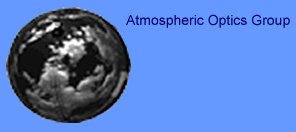
 |
| |
|
|
|
|
|
|
|
Calibration of Sensors - DetailThe Reason for Calibrating the SensorsThe Whole Sky Imagers are calibrated in order to provide an absolute radiance distribution over the whole sky. As an example, with the Daylight Visible-NIR WSI, which has approximately 1k x 1k resolution, approximately 700,000 pixels are acquired in a typical image. When these signals are processed to yield the absolute radiance in each direction, the result is a 700,000 point distribution of radiance measured over the sky at 1/6 degree angular resolution, with all points acquired simultaneously. Even under starlight, the signals may be calibrated. Typical signal-to-noise ratios for the signal from the dark part of the sky between stars are approximately 40 – 60. The ability to measure the absolute radiance distribution over the sky at a high spatial resolution, at reasonably high temporal resolution, and in several filters is unique, to the best of our knowledge. Applications include evaluating models for climate research, determination of beam transmittance distribution, and any other applications that require a knowledge of the sky radiance distribution.
Produced
by the Marine Physical Laboratory, SIO.
|